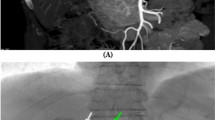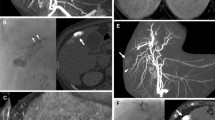Abstract
Purpose
To compare the accuracy of the conventional and portal vein tracing methods in the right hepatic lobe in multidetector computed tomography (MDCT).
Materials and methods
This retrospective study included patients with hepatocellular carcinoma (HCC) lesions in the right hepatic lobe who underwent multiphasic MDCT and C-arm CT hepatic arteriography (C-arm CTHA) for chemoembolization. The accuracies of the conventional and portal vein tracing methods were evaluated using C-arm CTHA as the gold standard.
Results
A total of 147 patients with 205 HCC nodules were included. The C-arm CTHA could identify all the tumour-feeding arteries and consequently demonstrated that 120 lesions were located in the anterior section, 78 in the posterior section, and 7 in the border zone. The accuracy rates of conventional vs. portal vein tracing methods were 71.7 % vs. 98.3 % for the anterior section lesions, 67.9 % vs. 96.2 % for the posterior section, and 28.6 % vs. 57.1 % for the border zone. The portal vein tracing method was more accurate than the conventional method (P<0.001).
Conclusions
The portal vein tracing method should be used for sectional localization of HCCs in the right lobe, because it predicts the location more accurately than the conventional method.
Key Points
• Portal tracing method is more accurate than conventional method for tumour localization.
• The conventional method is especially inaccurate in right anteroinferior or posterosuperior quadrants.
• Scissurae between right anterior and posterior section may not be vertical but tilted.


Similar content being viewed by others
References
Bismuth H (1982) Surgical anatomy and anatomical surgery of the liver. World J Surg 6:3–9
Couinaud C (1957) Le foie: études anatomiques et chirurgicales. Masson & Cie
Nelson R, Chezmar J, Sugarbaker P, Murray D, Bernardino M (1990) Preoperative localization of focal liver lesions to specific liver segments: utility of CT during arterial portography. Radiology 176:89–94
Cho A, Okazumi S, Takayama W et al (2000) Anatomy of the Right Anterosuperior Area (Segment 8) of the Liver: Evaluation with Helical CT during Arterial Portography 1. Radiology 214:491–495
Fasel J, Selle D, Evertsz C, Terrier F, Peitgen H, Gailloud P (1998) Segmental anatomy of the liver: poor correlation with CT. Radiology 206:151–156
Lee HY, Chung JW, Lee JM et al (2007) A new and simple practical plane dividing hepatic segment 2 and 3 of the liver: evaluation of its validity. Korean J Radiol 8:302–310
Liu XJ, Zhang JF, Sui HJ et al (2013) A comparison of hepatic segmental anatomy as revealed by cross‐sections and MPR CT imaging. Clin Anat 26:486–492
Ohashi I, Ina H, Okada Y et al (1996) Segmental anatomy of the liver under the right diaphragmatic dome: evaluation with axial CT. Radiology 200:779–783
Shindoh J, Mise Y, Satou S, Sugawara Y, Kokudo N (2010) The intersegmental plane of the liver is not always flat-tricks for anatomical liver resection. Ann Surg 251:917–922
Strunk H, Stuckmann G, Textor J, Willinek W (2003) Limitations and pitfalls of Couinaud's segmentation of the liver in transaxial imaging. Eur Radiol 13:2472–2482
Van Leeuwen MS, Noordzij J, Fernandez M, Hennipman A, Feldberg M, Dillon E (1994) Portal venous and segmental anatomy of the right hemiliver: observations based on three-dimensional spiral CT renderings. AJR Am J Roentgenol 163:1395–1404
Wallace MJ, Kuo MD, Glaiberman C, Binkert CA, Orth RC, Soulez G (2008) Three-dimensional C-arm cone-beam CT: applications in the interventional suite. J Vasc Interv Radiol 19:799–813
Paul J, Mbalisike EC, Vogl TJ (2014) Ultrafast cone-beam computed tomography imaging and postprocessing data during image-guided therapeutic practice. Eur Radiol 24:2866–2875
Iwazawa J, Ohue S, Mitani T et al (2009) Identifying feeding arteries during TACE of hepatic tumors: comparison of C-arm CT and digital subtraction angiography. Am J Roentgenol 192:1057–1063
Kakeda S, Korogi Y, Ohnari N et al (2007) Usefulness of cone-beam volume CT with flat panel detectors in conjunction with catheter angiography for transcatheter arterial embolization. J Vasc Interv Radiol 18:1508–1516
Kim HC, Chung JW, Lee IJ et al (2011) Intercostal artery supplying hepatocellular carcinoma: demonstration of a tumor feeder by C-arm CT and multidetector row CT. Cardiovasc Intervent Radiol 34:87–91
Kim HC, Chung JW, Park JH et al (2009) Transcatheter arterial chemoembolization for hepatocellular carcinoma: prospective assessment of the right inferior phrenic artery with C-arm CT. J Vasc Interv Radiol 20:888–895
Miyayama S, Yamashiro M, Okuda M et al (2009) Usefulness of cone-beam computed tomography during ultraselective transcatheter arterial chemoembolization for small hepatocellular carcinomas that cannot be demonstrated on angiography. Cardiovasc Intervent Radiol 32:255–264
Virmani S, Ryu RK, Sato KT et al (2007) Effect of C-arm angiographic CT on transcatheter arterial chemoembolization of liver tumors. J Vasc Interv Radiol 18:1305–1309
Wallace MJ, Murthy R, Kamat PP et al (2007) Impact of C-arm CT on hepatic arterial interventions for hepatic malignancies. J Vasc Interv Radiol 18:1500–1507
Vogl TJ, Schaefer P, Lehnert T et al (2015) Intraprocedural blood volume measurement using C-arm CT as a predictor for treatment response of malignant liver tumours undergoing repetitive transarterial chemoembolization (TACE). Eur Radiol:1–9
Bruix J, Sherman M (2011) Management of hepatocellular carcinoma: an update. Hepatology 53:1020–1022
Pugh R, Murray‐Lyon I, Dawson J, Pietroni M, Williams R (1973) Transection of the oesophagus for bleeding oesophageal varices. Br J Surg 60:646–649
Rieker O, Mildenberger P, Hintze C, Schunk K, Otto G, Thelen M (2000) Segmental anatomy of the liver in computed tomography: do we localize the lesion accurately? RoFo: Fortschritte auf dem Gebiete der Rontgenstrahlen und der Nuklearmedizin 172:147–152
Cho A, Okazumi S, Miyazawa Y et al (2005) Proposal for a reclassification of liver based anatomy on portal ramifications. Am J Surg 189:195–199
Ibukuro K, Takeguchi T, Fukuda H et al (2012) Spatial relationship between intrahepatic artery and portal vein based on the fusion image of CT-arterial portography (CTAP) and CT-angiography (CTA): New classification for hepatic artery at hepatic hilum and the segmentation of right anterior section of the liver. Eur J Radiol 81:e158–e165
Kaneko T, Tomiyama T, Kiyuna H, Machida T, Hayashi H, Kumita S-i (2010) Identification of Ryu's segmentation of the liver using MDCT analysis. J Nippon Med Sch 77
Kogure K, Kuwano H, Fujimaki N, Ishikawa H, Takada K (2002) Reproposal for Hjortsjo's segmental anatomy on the anterior segment in human liver. Arch Surg 137:1118–1124
Acknowledgments
The scientific guarantor of this publication is Jin Wook Chung. The authors of this manuscript declare no relationships with any companies whose products or services may be related to the subject matter of the article. This study has received funding by National Research and Development Program for Cancer Control, Ministry of Health and Welfare. No complex statistical methods were necessary for this paper. Institutional Review Board approval was obtained. Written informed consent was waived by the Institutional Review Board. Methodology: retrospective, observational, performed at one institution.
Author information
Authors and Affiliations
Corresponding author
Rights and permissions
About this article
Cite this article
Zhou, CG., Chung, J.W., Hur, S. et al. Sectional Localization of a Small Hepatocellular Carcinoma in the Right Hepatic Lobe by Computed Tomography: Comparison between the Conventional and Portal Vein Tracing Methods. Eur Radiol 26, 4524–4530 (2016). https://doi.org/10.1007/s00330-016-4297-3
Received:
Revised:
Accepted:
Published:
Issue Date:
DOI: https://doi.org/10.1007/s00330-016-4297-3




